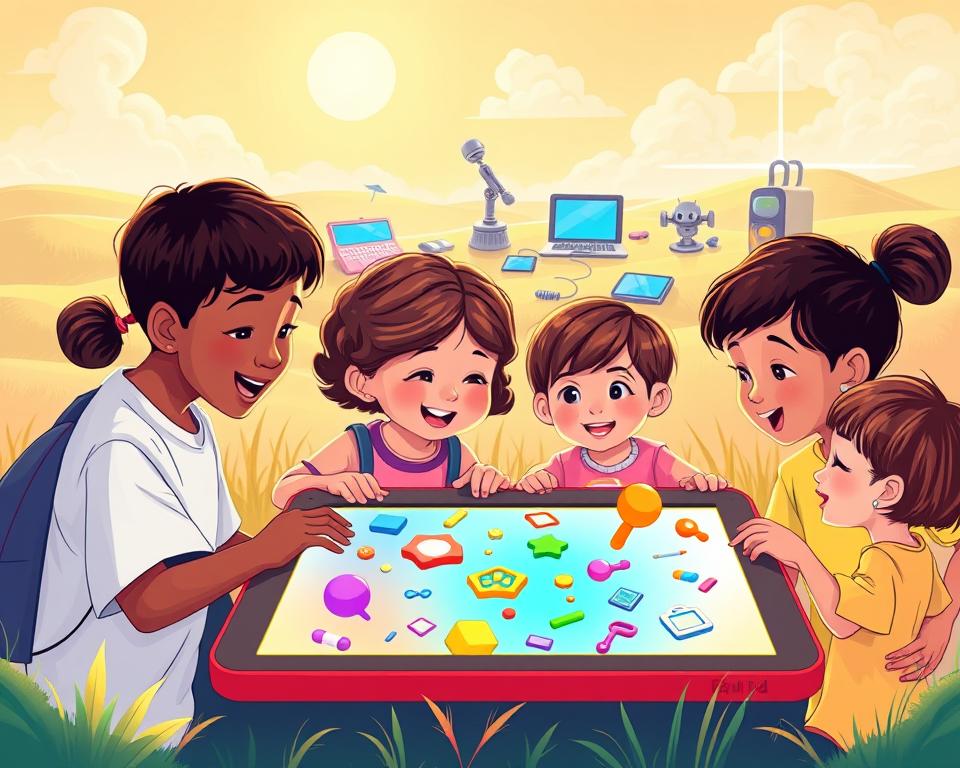
What is Technology? A Simple Explanation for Students
Did you know that, according to the World Economic Forum, estimates suggest that over 60% of jobs today will require significant technological skills by 2025? This staggering statistic highlights the importance of understanding technology for today’s students. Technology encompasses a wide range of tools, machines, and systems that enhance our daily lives, from simple tools like hammers to complex devices like smartphones and the internet. A simple definition of technology for students can be seen as the application of scientific knowledge to solve problems and improve life. It’s crucial for students to grasp this concept, as it equips them to navigate an increasingly digital world. By understanding the essence of technology, learners can understand how various devices and applications function together, enhancing communication and information sharing. Resources like Britannica and the Encyclopedia of Technology provide valuable insights into both historical and modern technologies.

Key Takeaways
- Technology is vital for modern education and skills development.
- Understanding technology helps students solve real-world problems.
- A simple definition of technology includes both tools and systems.
- Students benefit from learning how technology enhances communication.
- Investing time in tech education prepares students for future careers.
Understanding Technology
Technology for students encompasses various fields that combine science and engineering. It aims to develop practical solutions that address real-world challenges. Recognizing what technology entails benefits learning, as it encompasses everything from simple gadgets to complex systems.
To understand technology defined for children, one can look at everyday items. For instance, smartphones, computers, and household appliances showcase how technology enhances daily life. By exploring these examples, students can connect their experiences with broader concepts, enriching their understanding of technology.

When students see technology in action, such as in their schools or communities, it becomes more relatable. Engaging with technology opens minds to possibilities. This connection fosters a greater appreciation of how technology impacts our lives, both now and in the future.
Simple Definition of Technology for Students
Understanding technology can be quite simple. A basic concept is the application of scientific knowledge to develop tools and systems that enhance our daily lives. This simple definition of technology for students captures its essence and sets the stage for deeper exploration.
Breaking Down the Concept
To grasp what is technology for students, consider its core components: invention, engineering, and implementation. Invention refers to creating new ideas or products, while engineering involves designing and constructing these inventions. Implementation means putting these tools into action, making them useful in various scenarios. Technology simplified for students emphasizes these elements as integral to a cohesive understanding.
Real-World Examples
Real-life applications help clarify the significance of technology. Smartphones represent a powerful tool for communication, connecting people instantly regardless of distance. Medical devices like heart monitors illustrate technology’s role in enhancing health and patient care. Educational apps transform how students learn, providing interactive and engaging experiences. By examining these examples, students see how technology influences their lives, underscoring the importance of a simple definition of technology for students.

| Technology | Purpose | Impact |
|---|---|---|
| Smartphones | Communication | Connects people worldwide |
| Medical Devices | Health Monitoring | Enhances patient care |
| Educational Apps | Learning Enhancement | Engages students interactively |
The Importance of Technology in Daily Life
Understanding the impact of technology in our everyday experiences is essential for students. Technology basics for students encompass the transformative ways it enhances communication and simplifies daily tasks. A solid grasp of these concepts will help students appreciate how technology plays a vital role in modern life.
Enhancing Communication
Technology revolutionizes communication, breaking down barriers that once existed. With the rise of instant messaging and video calling, connecting with friends and family, regardless of distance, has never been easier. Social networking platforms allow users to share experiences and stay updated on each other’s lives. This landscape fosters connections that are crucial in today’s fast-paced world.
Making Life Easier
Beyond communication, technology simplifies various daily problems. Online shopping transforms the way people purchase items, making it convenient to find what you need from the comfort of home. Digital banking and finance apps allow for efficient management of personal finances without the hassle of traditional banking. Understanding these advancements provides a valuable technology explanation for kids, showcasing how technology streamlines life.

Types of Technology
In today’s world, technology plays a vital role across various sectors. Each type of technology serves unique functions that contribute to our daily lives. Understanding the different categories of technology helps us grasp its extensive applications.
Information Technology
Information technology focuses on the use of computers and communication systems to manage data. This field includes everything from software development to online communication tools. With growing reliance on technology, IT enhances how we process and share information.
Medical Technology
Medical technology involves innovative tools that improve healthcare. This includes diagnostic equipment, imaging technologies, and telehealth services. These advancements enhance patient care and make medical treatments more efficient.
Environmental Technology
Environmental technology aims for sustainability and protecting our planet. Innovations in this category include renewable energy sources such as solar and wind power. By focusing on eco-friendly solutions, this type of technology plays a crucial role in preserving natural resources.

| Type of Technology | Main Focus | Examples |
|---|---|---|
| Information Technology | Data processing and communication | Software, Networking |
| Medical Technology | Healthcare innovations | X-Rays, Telemedicine |
| Environmental Technology | Sustainability efforts | Solar Panels, Wind Turbines |
Recognizing these types of technology helps in understanding technology meaning simplified and makes technology defined simply for kids more relatable. Each category serves its purpose while contributing to the larger technological framework that shapes our world.
How Technology Has Evolved
Understanding the evolution of technology offers students a glimpse into how we reached our current state of innovation. From the initial use of simple tools, humanity has progressed to complex devices that shape our daily lives. A simple definition of technology for students could begin with noting these historical milestones that transformed societies.
The invention of the wheel marked an important turning point in human history, enabling easier transportation and trade. Following this, the printing press revolutionized communication, allowing ideas to spread quickly and widely. The internet emerged as another groundbreaking development, changing how people connect, share information, and conduct business.
Such advancements are crucial for helping students grasp the concept of technology defined for children. Each historical event highlights how technology adapts to meet human needs and desires. Looking back at these milestones allows students to appreciate the continuous journey of innovation and its impact on culture and society.
As we navigate the modern world, it’s vital to understand that technology will keep evolving. The skills and knowledge acquired today will prepare students for the technological challenges and opportunities of tomorrow.
Technology Explanation for Kids
Understanding technology can be exciting for kids, as it paints a picture of how far we’ve come and where we are heading. By looking at inventions through the years, it becomes easier to grasp the concept of technology simplified for students. From past devices like the fax machine to the cloud computing systems we use today, kids can see the evolution of tools and their functionalities.
From the Past to the Present
Technology has evolved significantly over the decades. For instance, the fax machine was once essential for sending documents quickly, but now email and cloud storage have taken over this role. This transition is a great way to provide a technology explanation for kids, showcasing how solutions adapt to our changing needs. Children can appreciate that innovation is all about improving our lives and making tasks easier.
Looking Towards the Future
As we look toward the future, it’s clear that new technologies like artificial intelligence and virtual reality will influence daily life. These advancements can inspire young minds, revealing potential career paths and creative opportunities. Understanding these trends can motivate children to explore their interests in technology simplified for students, guiding them to become innovators of tomorrow.
Technology Basics for Students
Understanding the technology basics for students lays a strong foundation for grasping more complex concepts in the digital age. Key components that make up technology include hardware, software, data, and processes. Familiarity with these elements helps students appreciate how various devices and applications function together effectively.
Key Components of Technology
Each component serves a distinct purpose:
- Hardware: Physical devices, such as computers, tablets, and smartphones.
- Software: Programs and applications that allow users to perform tasks on hardware.
- Data: Information processed and stored by technology systems.
- Processes: Procedures or methods used to complete tasks using technology.
Tools and Applications
A wide array of tools and applications enriches the learning experience. Examples include:
- Educational software: Programs like Google Classroom and Microsoft Teams enhance collaboration and learning.
- Online resources: Websites that offer tutorials and courses on various subjects.
- Creative tools: Applications for graphic design, video editing, and coding.
By understanding these technology basics for students, individuals can simplify the technology meaning simplified, making it accessible for all. With the right tools at their disposal, students can develop essential skills that prepare them for future challenges.
Technology Meaning Simplified
Understanding technology can be made easy when we focus on its basic idea. At its core, technology refers to the tools and methods designed to help us solve problems or improve our lives. This definition reflects the essence of what technology defined simply for kids should convey.
When explaining technology for students, using everyday examples can make the concept relatable. For instance, a smartphone is more than just a phone; it combines communication, information access, and many apps that assist in daily tasks. Such examples help students visualize how technology functions in their lives, reinforcing their understanding.
Visual aids, like diagrams or videos, can also enhance the learning experience. These tools complement explanations, making the concept of technology more engaging and less intimidating for students.
By breaking down complex ideas into simpler terms, students gain confidence in their ability to grasp technology’s role in the world. This simplified approach ensures that technology defined simply for kids translates into practical knowledge for students of all ages.
Technology Defined Simply for Kids
Understanding technology can be exciting for children. Think of it as a big toolbox filled with different tools that help us solve problems and complete tasks. For instance, a computer can be seen as a powerful tool to create artwork, play games, or communicate with friends. This technology definition for children shows how technology surrounds us in everyday life.
To make a technology explanation for kids even clearer, we can use examples they encounter daily. For example, smartphones let us call family members, take photos, or listen to music, all at our fingertips. It’s like having a magic wand that makes life easier and more fun!
When kids learn about technology, they discover how it plays a role in their lives. From digital apps that help with homework to online games connecting them with friends, these tools enhance their learning experiences. Understanding technology opens up a world of possibilities and prepares them for a future where technology will only become more integral to our lives.
The Role of Technology in Education
In today’s educational landscape, technology plays a crucial role in enhancing learning experiences. The incorporation of various tools and resources supports teachers in delivering lessons that resonate with their students. Understanding technology meaning simplified can help educators and students alike navigate the digital learning environment more effectively.
Learning Tools and Resources
Classrooms now benefit from interactive tools such as smartboards, tablets, and online learning platforms. These resources create an engaging space where students can easily access information and collaborate with peers. By leveraging technology basics for students, educational institutions can provide tailored learning experiences that adapt to individual needs.
Engaging Students through Technology
Innovative approaches like gamification have transformed traditional learning methods. This strategy introduces game-like elements into lessons, motivating students to participate actively and learn at their own pace. With technology integrated into curricula, educators can foster environments where creativity flourishes, and students feel empowered to explore new concepts.
The Impact of Technology on Society
Technology significantly influences various aspects of society, shaping our experiences and interactions. A simple definition of technology for students emphasizes its role in solving problems and enhancing daily life. Understanding technology defined for children can help young minds grasp both its benefits and challenges.
Positive Changes
Numerous advancements driven by technology have led to positive transformations in society. Some notable improvements include:
- Healthcare Advances: Technology has improved diagnostics, treatment options, and patient care, leading to longer, healthier lives.
- Enhanced Communication: With the rise of smartphones and social media, staying connected across distances has become easier than ever.
- Access to Information: The internet provides vast resources, enabling instant access to knowledge and educational materials.
Challenges We Face
While technology presents numerous advantages, it also brings forth significant challenges that must be recognized:
- Digital Privacy Concerns: The collection and use of personal data raise issues regarding individual privacy and security.
- Misinformation: The rapid spread of false information online can affect public understanding and trust.
- The Digital Divide: Access to technology varies globally, creating disparities in education and opportunities among different communities.
Benefits of Understanding Technology
Grasping the principles of technology opens a world of advantages for students. The knowledge gained fosters essential skills required for success in today’s digital landscape. As technology plays a significant role in various fields, a foundational understanding prepares young learners for diverse career opportunities while enhancing their cognitive abilities.
Preparation for Future Careers
Equipping students with technological knowledge empowers them to navigate an increasingly complex job market. Familiarity with technology for students contributes to adaptability and innovation in various professions. Roles in fields like information technology, engineering, and creative industries demand a strong technological background. Introducing technology explained simply for kids can spark interest in these areas, guiding them towards lucrative career paths.
Improving Problem-Solving Skills
Learning about technology enhances critical thinking and problem-solving abilities. Students trained in technology develop the agility needed to learn new tools and methods, which are crucial in today’s fast-paced environment. Skills acquired through technology education facilitate innovative solutions to real-world problems, making them invaluable contributors to society.
Technological Innovations to Watch
Students today stand at the forefront of exciting technological innovations that promise to reshape the future. Understanding these advancements helps demystify technology meaning simplified, making it easier for young learners to engage with new ideas. Two noteworthy innovations are Artificial Intelligence (AI) and Virtual Reality (VR), which have applications across various industries and settings.
Artificial Intelligence
Artificial Intelligence is revolutionizing how we interact with technology. Automated systems streamline operations in healthcare, finance, and transportation. For instance, AI enhances diagnostic processes in hospitals, ensuring timely and accurate patient care. Educational institutions implement AI-driven tools to personalize learning experiences, catering to individual student needs. Exploring these applications reveals the significant role AI plays in understanding technology basics for students and preparing them for future careers.
Virtual Reality
Virtual Reality offers immersive experiences that engage users in unique ways. In entertainment, gamers find themselves transported into fantastic worlds, while in education, VR facilitates interactive learning. Students can take virtual field trips to historical sites or dive into scientific explorations that make learning more tangible and exciting. This innovation not only entertains but also opens up new pathways for students to connect with complex subjects, further enforcing technology basics for students.
Common Misconceptions About Technology
Many people, especially students, may wonder what is technology for students and how it applies to their daily lives. Some misconceptions might make technology appear limited to computers and smartphones. In reality, technology stretches beyond these gadgets into various fields such as medicine, agriculture, and even art. Understanding this broader scope is vital for students to grasp the essential roles technology plays in society.
Another prevalent misunderstanding is the idea that technology is invariably beneficial. While it offers numerous advantages like enhanced communication and efficiency, it can also lead to challenges such as privacy concerns and environmental issues. By recognizing these dual aspects, students can better understand the implications of using technology. This balanced perspective is crucial when teaching technology defined simply for kids.
Promoting awareness about these misconceptions not only helps students appreciate technology’s complexities but also prepares them for informed decision-making. Cultivating critical thinking regarding technology encourages responsible use, guiding them towards becoming thoughtful contributors to future innovations.
| Misconception | Reality |
|---|---|
| Technology is only about computers. | Technology is present in many areas, including medicine, education, and entertainment. |
| All technology is good. | While technology offers benefits, it can also cause issues like privacy concerns and environmental impact. |
| Learning about technology is not necessary. | Understanding technology prepares students for personal and professional success in a tech-driven world. |
| Technology is static. | Technology constantly evolves, leading to new tools and methods that change how we live and work. |
Conclusion
Understanding technology is crucial, especially for students who are navigating a world where it plays an integral role in everyday life. Throughout this article, we have explored the simple definition of technology for students, uncovering its various forms and applications. From enhancing communication to revolutionizing education, technology’s impact is profound and far-reaching.
The technology explanation for kids emphasizes that technology is not just about devices or gadgets; it’s about problem-solving and innovation. By engaging with technology thoughtfully, students can develop essential skills that prepare them for future careers while significantly improving their problem-solving abilities.
As students learn and grow, grasping the concepts discussed throughout the article will enable them to appreciate technology’s essential role in shaping their futures and the world around them. Embracing technology with curiosity and critical thinking ensures that they are well-equipped to navigate the challenges and opportunities that lie ahead.



